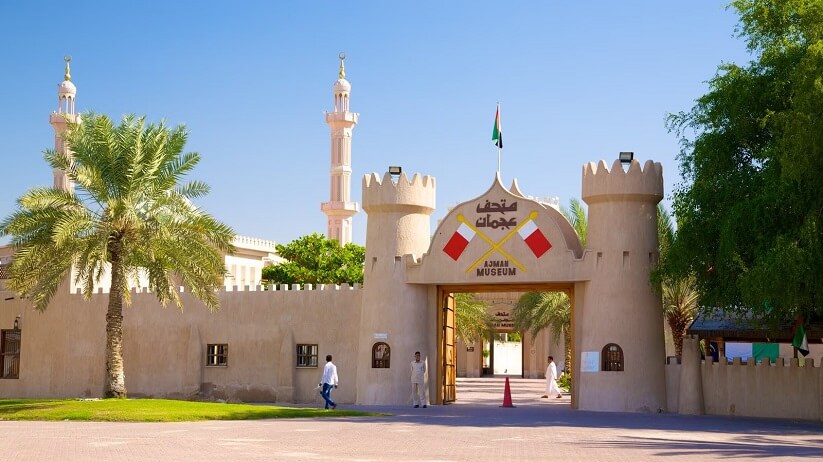
Posted On: 20-09-2023
The smallest of the seven emirates, Ajman, is filled with fascinating locations and cultural gems that showcase the region's rich history. The Ajman Museum, commonly known as the Ajman Fort Museum, is one of the most important historical sites in this charming emirate. H.H. Sheikh Rashid Bin Humaid meticulously looked after this castle, which was built from coral stone and gypsum, until he died in 1838.
Ancient manuscripts, ingenious irrigation systems, and conventional wooden dhows are all displayed in the historical place. Here is a sample of what the Ajman Museum has to offer.
Sheikh Al Nuaimi and his followers took possession of the seaside town of the Emirates in 1816 after triumphantly defeating the Al Bu Shamis clan.
Soon after, they seized control of Ajman Fort and founded the Nuaimi dynasty, which continues to rule the Emirate to this day.
The region's ruling family's residence and main line of defense was the fort built in the eighteenth century.
The structure consists of a palace, two barrel wind towers, and two watchtowers. These features have been kept, even though the fort has undergone renovations throughout the years. Visitors can also see the magnificent gate and two cannons that are located at the historical place's entrance.
Also Read: Saqr Park Ras Al Khaimah
The fort was used as a police station from 1970 and 1978, and artifacts from that period can still be found in the historical place collection.
The Ajman Fort was converted into a museum in 1981. As you can see, the Ajman Museum's past is just as interesting as the artifacts it is home to.
Numerous antiquity artifacts from the emirate's past are housed in this historical attraction. Clay jars, welds, pearling equipment, and fishing gear are a few among them.
With realistic dioramas of traditional Bedouin markets, weddings, fishing, and agriculture, you are transported back in time. The museum's exhibits are arranged chronologically and have labels in both Arabic and English.
You will be welcomed with a stunning exhibit showing off an unearthed cemetery as soon as you enter this historical place.
The ceramics and burial jewelry on show date back to 3000 BC and were found in the Al Mowaihat region. The first known human settlement in the emirate is at this place. It's interesting to note that the Al Mowaihat neighborhood is still a thriving residential neighborhood with roomy homes available for rent.
Similar to several other archaeological finds, this site was discovered in 1986 entirely by accident.
Construction workers unintentionally discovered copper, pottery, beads, and other artifact fragments while excavating the region for their project.
These discoveries, which correspond to what can be called the Emirate's own Bronze Age, were dated to a time of about 2500 BC.
Furthermore, the historical place has a special section with exhibits connected to pearl fishing because fishing was a significant part of the economy of old Ajman.
In this Emirate of UAE, fishing is still a well-liked pastime for both locals and visitors. You have a lot of options for casting your lines while taking in the cooling sea wind thanks to the emirate's wide coastline.
It's crucial to remember that a particular fishing license is necessary because UAE authorities uphold rigorous restrictions for the preservation of marine life. In this attraction, tourists have the choice to go on deep-sea fishing excursions offered by authorized vendors.
Each replica in the museum's collection of traditional life depictions has been painstakingly recreated with such attention to detail that it is virtually impossible to tell that you are viewing a professionally produced recreation.
A fascinating display also includes a barber mannequin complete with bloodstains from his clients' heads.
As we continue our exploration, we realize that the historical place has sections devoted to various region-related archaeological discoveries. There are other rooms with artifacts from the region's police department and even the first radio station in the emirate.
Notably, the Trucial Sheikhs and the British signed a deal in 1843, and in 1853, the coastal Sheikhs and the British signed the "Perpetual Treaty of Peace."
According to the Wikipedia entry for the Ajman Museum, a copy of this historic treaty can be found in the 'Documents & Manuscripts' section.
The historical place is close to both the Gold and Traditional Souqs because it is located in the heart of the city, on the eastern side of the main plaza in the Al Bustan neighborhood.
Its handy proximity to the Corniche makes it the perfect place for a weekend vacation in the Emirates.
It takes around an hour to travel via Sheikh Mohammed Bin Zayed Road if you are coming from Dubai. Furthermore, using a bus is an easy way to go to the fascinating attraction.
The Ajman Museum is open on the following days and times:
The following entrance fees are mentioned:
The Ajman Museum's admission costs are as follows:
The Ajman Museum is the ideal location if you want to fully immerse yourself in the pre-oil era of the area and the time before the Emirates were united. In essence, going back in time is one of the best things to do in the following Emiarte in the UAE.
